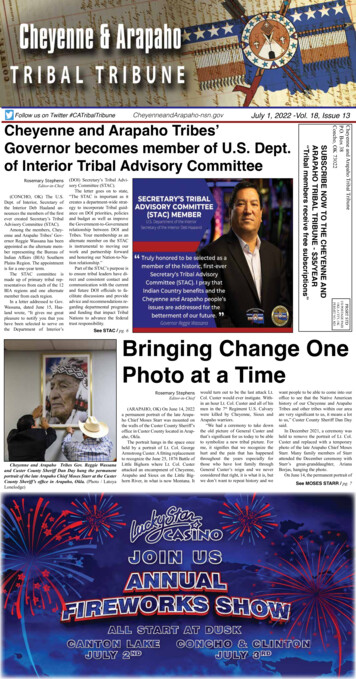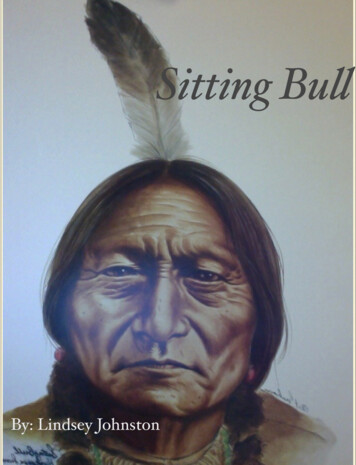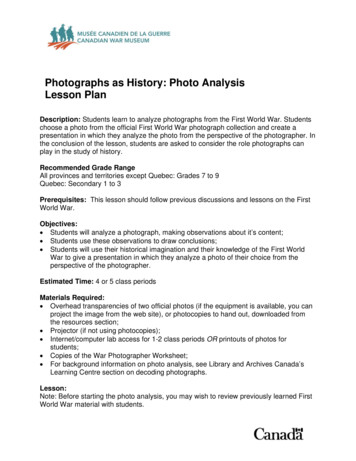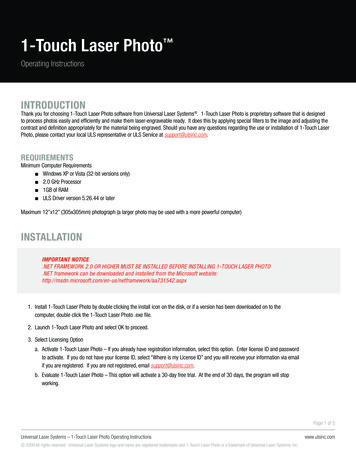
Transcription
CheyenneandArapaho-nsn.govFollow us on Twitter #CATribalTribuneJuly 1, 2022 -Vol. 18, Issue 13PRSRT STDUS POSTAGE PAIDOKLA CITY, OKPERMIT NO. 823(CONCHO, OK) The U.S.Dept. of Interior, Secretary ofthe Interior Deb Haaland announces the members of the firstever created Secretary’s TribalAdvisory Committee (STAC).Among the members, Cheyenne and Arapaho Tribes’ Governor Reggie Wassana has beenappointed as the alternate member representing the Bureau ofIndian Affairs (BIA) SouthernPlains Region. The appointmentis for a one-year term.The STAC committee ismade up of primary tribal representatives from each of the 12BIA regions and one alternatemember from each region.In a letter addressed to Gov.Wassana, dated June 15, Haaland wrote, “It gives me greatpleasure to notify you that youhave been selected to serve onthe Department of Interior’s(DOI) Secretary’s Tribal Advisory Committee (STAC).The letter goes on to state,“The STAC is important as itcreates a department-wide strategy to incorporate Tribal guidance on DOI priorities, policiesand budget as well as improvethe Government-to-Governmentrelationship between DOI andTribes. Your membership as analternate member on the STACis instrumental to moving ourwork and partnership forwardand honoring our Nation-to-Nation relationship.”Part of the STAC’s purpose isto ensure tribal leaders have direct and consistent contact andcommunication with the currentand future DOI officials to facilitate discussions and provideadvice and recommendations regarding departmental programsand funding that impact TribalNations to advance the federaltrust responsibility.See STAC / pg. 6Bringing Change OnePhoto at a TimeRosemary StephensEditor-in-ChiefCheyenne and Arapaho Tribes Gov. Reggie Wassanaand Custer County Sheriff Dan Day hang the permanentportrait of the late Arapaho Chief Moses Starr at the CusterCounty Sheriff’s office in Arapaho, Okla. (Photo / LatoyaLonelodge)Cheyenne and Arapaho Tribal TribuneP.O. Box 38Concho, OK 73022Rosemary StephensEditor-in-ChiefSUBSCRIBE NOW TO THE CHEYENNE ANDARAPAHO TRIBAL TRIBUNE - 35/YEAR“Tribal members receive free subscriptions”Cheyenne and Arapaho Tribes’Governor becomes member of U.S. Dept.of Interior Tribal Advisory Committee(ARAPAHO, OK) On June 14, 2022a permanent portrait of the late Arapaho Chief Moses Starr was mounted onthe walls of the Custer County Sheriff’soffice in Custer County located in Arapaho, Okla.The portrait hangs in the space onceheld by a portrait of Lt. Col. GeorgeArmstrong Custer. A fitting replacementto recognize the June 25, 1876 Battle ofLittle Bighorn where Lt. Col. Custerattacked an encampment of Cheyenne,Arapaho and Sioux on the Little Bighorn River, in what is now Montana. Itwould turn out to be the last attack Lt.Col. Custer would ever instigate. Within an hour Lt. Col. Custer and all of hismen in the 7th Regiment U.S. Calvarywere killed by Cheyenne, Sioux andArapaho warriors.“We had a ceremony to take downthe old picture of General Custer andthat’s significant for us today to be ableto symbolize a new tribal picture. Forme, it signifies that we recognize thehurt and the pain that has happenedthroughout the years especially forthose who have lost family throughGeneral Custer’s reign and we neverconsidered that right, it is what it is, butwe don’t want to repeat history and wewant people to be able to come into ouroffice to see that the Native Americanhistory of our Cheyenne and ArapahoTribes and other tribes within our areaare very significant to us, it means a lotto us,” Custer County Sheriff Dan Daysaid.In December 2021, a ceremony washeld to remove the portrait of Lt. Col.Custer and replaced with a temporaryphoto of the late Arapaho Chief MosesStarr. Many family members of Starrattended the December ceremony withStarr’s great-granddaughter, ArianaBorjas, hanging the photo.On June 14, the permanent portrait ofSee MOSES STARR / pg. 7
Cheyenne & Arapaho Tribal TribunePAGE 2Tsistsistas & HinonoeiCheyenne and Arapaho Tribes TelevisionStation Celebrates 10-year AnniversaryLatoya LonelodgeStaff Reporter(CONCHO, OK) A decade of programming.The Cheyenne and ArapahoTelevisionStation(CATV) celebrate its 10-yearanniversary of producingquality educational videosand film.CATV is a low powerpublic educational TV station owned by the Cheyenneand Arapaho Tribes in operation since 2012. It was thefirst Native owned televisionstation in the state of Oklahoma.Since its inception, Randy Burleson, CATV director,and Darren Brown, seniorcontent producer, have beenworking and producing content alongside talented staffmembers of the CATV program throughout the years.Current CATV staff includesAdam Youngbear, producer,Diego Hartico, videographer/editor, and Savannah Stein,administrative assistant.Throughout the years,CATV has had to adjust andtransition with the changingdemands of a television station on antenna TV to reachmore viewership in communities. While striving toproduce quality content forthe Cheyenne and ArapahoTribes and reach more communities, CATV airs on antenna TV channel 35 and hasexpanded their content to beviewed on Vimeo, YouTubeand social media sites suchas Facebook and Instagram.“Facebook and YouTubehave been around for mostof how our audiences engage with us and that’s ahuge thing because even ifeverybody around here hadan actual antenna, we stillcouldn’t reach them, we postsomething on Facebook andwe have over 10,000 or sofriends across the country, alldifferent tribes,” Brown said.Brown said when the program posts content to Facebook, people see it all overthe world and react to it. “Wecan see that they did that andthat’s pretty cool,” Brownsaid.While the station reachesinto Oklahoma City on air,if everybody had an antennatheir viewership could potentially reach a million viewers, however that wouldn’tbe realistic as most peoplehave cable or satellite butthat’ll soon change, Burlesonsaid.“We are working on appsCheyenne and Arapaho Television Station staff includes (l-r): Diego Hartico, Darren Brown, Savannah Stein, RandyBurleson, and not pictured Adam Youngbear. (Photo / Latoya Lonelodge)for Amazon, Fire TV, AppleTV, Roku and television appsso we’ll have our own appsthat people can download,if they can’t get our signalover the air, they can download our app and get it ontheir phone, their iPad, theirCheyenne and Arapaho Tribes Dept.of Health Hosts Men’s Health DayEach year in the weekleading up to Father’s Day,the United States recognizesMen’s Health Week to raiseawareness of the diseases and illnesses that affectmen. By better understanding the unique risk factorsthat men face, efforts to promote healthier lifestyles andimplement more effectiveprevention and treatment options for men can be taken.In recognition of National Men’s Health Week,the Cheyenne and Arapaho Tribes’ Dept. of Healthhosted a Men’s Health Dayat Lake El Reno on June 13,2022.In support of Men’sHealth Week, the UnitedStates’ 117th Congress authored a resolution in 2020,which states, in part, “Despite advances in medicaltechnology and research,men continue to live an average of more than five yearsless than women, and American Indian/Alaska Nativesand African American menhave the lowest life expectancy in the U.S.”Diseases such as heartdisease, cancer, diabetes,and unintentional injuries,according to the Centers forDisease Control and Prevention, lead to death in menat a higher percentage thanwomen.Suicide is among the top10 causes of death for menand ranks as the second highest cause of death for men intwo age groups, from ages 15– 44, and men on average experience a heart attack sevenyears earlier than women.The goal of Men’s HealthWeek is to bring awarenessof preventable health problems and encourage early detection and treatment of disease among men and boys.To learn more aboutMen’s Health Week visitwww.menshealthmonth.org.Staff members of the Cheyenne and Arapaho Tribes’ Dept. of Health and Gov. ReggieWassana during the Men’s Health Day event in El Reno, Okla.computer or their smart TV,”Burleson said.Having worked in CATVfor as long as the programhas been in operation,Burleson said it’s been interesting to work every dayas there’s always somethingnew and different to do.“I haven’t been bored oneday in this job there’s always something for me to dowhether it’s a technical challenge I have to face, planningor helping these guys withtheir projects, there’s alwayssomething to think about, toplan to do to keep up withthe demand of the TV stations, so we’re always busy,”Burleson said.For Brown, 10 years atCATV has been relativelySee CATV / pg. 5
Tsistsistas & HinonoeiCheyenne & Arapaho Tribal TribunePAGE 3How the Battle of Little Bighorn was WonAccounts of the 1876 battle have focused on Custer’s ill-fated cavalry. But a book published by Thomas Powers offers a take from the Indian’s point of viewBy Thomas Powers, Smithsonian MagazineIn 1874, an Army expedition led by Lt.Col. George Armstrong Custer found gold inthe Black Hills, in present-day South Dakota.At the time, the United States recognized thehills as property of the Sioux Nation, undera treaty the two parties had signed six yearsbefore. The Grant administration tried to buythe hills, but the Sioux, considering them sacred ground, refused to sell; in 1876, federal troops were dispatched to force the Siouxonto reservations and pacify the Great Plains.That June, Custer attacked an encampment ofSioux, Cheyenne and Arapaho on the LittleBighorn River, in what is now Montana.The Battle of the Little Bighorn is one ofthe most studied actions in U.S. military history, and the immense literature on the subjectis devoted primarily to answering questionsabout Custer’s generalship during the fighting. But neither he nor the 209 men in hisimmediate command survived the day, andan Indian counterattack would pin down seven companies of their fellow 7th Cavalrymenon a hilltop over four miles away. (Of about400 soldiers on the hilltop, 53 were killed and60 were wounded before the Indians endedtheir siege the next day.) The experience ofCuster and his men can be reconstructed onlyby inference.This is not true of the Indian version ofthe battle. Long-neglected accounts givenby more than 50 Indian participants or witnesses provide a means of tracking the fightfrom the first warning to the killing of thelast of Custer’s troopers, a period of abouttwo hours and 15 minutes. In his new book,The Killing of Crazy Horse, veteran reporterThomas Powers draws on these accounts topresent a comprehensive narrative account ofthe battle as the Indians experienced it. CrazyHorse’s stunning victory over Custer, whichboth angered and frightened the Army, ledto the killing of the chief a year later. “Mypurpose in telling the story as I did,” Powerssays, “was to let the Indians describe whathappened, and to identify the moment whenCuster’s men disintegrated as a fighting unitand their defeat became inevitable.”The sun was just cracking over the horizon that Sunday, June 25, 1876, as men andboys began taking the horses out to graze.First light was also the time for the women topoke up last night’s cooking fire. The Hunkpapa woman known as Good White Buffalo Woman said later she had often been incamps when war was in the air, but this daywas not like that. “The Sioux that morninghad no thought of fighting,” she said. “Weexpected no attack.”Those who saw the assembled encampment said they had never seen one larger. Ithad come together in March or April, even before the plains started to green up, accordingto the Oglala warrior He Dog. Indians arriving from distant reservations on the MissouriRiver had reported that soldiers were coming out to fight, so the various camps made apoint of keeping close together. There were atleast six, perhaps seven, cheek by jowl, withthe Cheyennes at the northern, or downriver, end near the broad ford where MedicineTail Coulee and Muskrat Creek emptied intothe Little Bighorn River. Among the Sioux,the Hunkpapas were at the southern end. Between them along the river’s bends and loopswere the Sans Arc, Brulé, Minneconjou, Santee and Oglala. Some said the Oglala werethe biggest group, the Hunkpapa next, withperhaps 700 lodges between them. The othercircles might have totaled 500 to 600 lodges.That would suggest as many as 6,000 to 7,000people in all, a third of them men or boys offighting age. Confusing the question of numbers was the constant arrival and departureof people from the reservations. Those travelers, plus hunters from the camps, women outgathering roots and herbs and seekers of losthorses—were part of an informal early-warning system.There were many late risers this morningbecause dances the previous night had ended only at first light. One very large tent nearthe center of the village, probably two lodgesraised side by side—was filled with the elders, called chiefs by the whites but “shorthairs,” “silent eaters” or “big bellies” by theIndians. As the morning turned hot and sultry, large numbers of adults and children wentswimming in the river. The water would havebeen cold; Black Elk, the future Oglala holyman, then 12, would remember that the riverwas high with snowmelt from the mountains.It was approaching midafternoon when areport arrived that U.S. troops had been spotted approaching the camp. “We could hardlybelieve that soldiers were so near,” the Oglala elder Runs the Enemy said later. It madeno sense to him or the other men in the biglodge. For one thing, whites never attackedin the middle of the day. For several moments more, Runs the Enemy recalled, “Wesat there smoking.”Other reports followed. White Bull, aMinneconjou, was watching over horses nearRosemary Stephens, Editor-in-Chief405-422-7446 / rmstephens@cheyenneandarapaho-nsn.govCuster's soldiers never made it across the river. "We circled all around them, swirlinglike water round a stone," the warrior Two Moons said. A series of short, sharp fights leftCuster and all 209 of his men dead, including his brothers Thomas and Boston. ( Photo /Aaron Huey)camp when scouts rode down from Ash Creekwith news that soldiers had shot and killedan Indian boy at the fork of the creek twoor three miles back. Women who had beendigging turnips across the river some milesto the east “came riding in all out of breathand reported that soldiers were coming,” saidthe Oglala chief Thunder Bear. “The country,they said, looked as if filled with smoke, somuch dust was there.” The soldiers had shotand killed one of the women. Fast Horn, anOglala, came in to say he had been shot at bysoldiers he saw near the high divide on theway over into the Rosebud valley.But the first warning to bring warriors onthe run probably occurred at the Hunkpapacamp around 3 o’clock, when some horseraiders, Arikara (or Ree) Indians working forthe soldiers, as it turned out, were seen making a dash for animals grazing in a ravine notfar from the camp. Within moments shooting could be heard at the south end of camp.Peace quickly gave way to pandemonium,shouts and cries of women and children, mencalling for horses or guns, boys sent to findmothers or sisters, swimmers rushing fromthe river, men trying to organize resistance,looking to their weapons, painting themselves or tying up their horses’ tails.As warriors rushed out to confront theCheyenne and Arapahohorse thieves, people at the southernmost endof the Hunkpapa camp were shouting alarmat the sight of approaching soldiers, firstglimpsed in a line on horseback a mile or twoaway. By 10 or 15 minutes past 3 o’clock,Indians had boiled out of the lodges to meetthem. Now came the first shots heard backat the council lodge, convincing Runs theEnemy to put his pipe aside at last. “Bulletssounded like hail on tepees and treetops,”said Little Soldier, a Hunkpapa warrior. Thefamily of chief Gall, two wives and theirthree children, were shot to death near theirlodge at the edge of the camp.But now the Indians were rushing outand shooting back, making show enough tocheck the attack. The whites dismounted. Every fourth man took the reins of three otherhorses and led them along with his own intothe trees near the river. The other soldiers deployed in a skirmish line of perhaps 100 men.It was all happening very quickly.As the Indians came out to meet the skirmish line, straight ahead, the river was totheir left, obscured by thick timber and undergrowth. To the right was open prairie rising away to the west, and beyond the end ofthe line, a force of mounted Indians rapidlyaccumulated. These warriors were swingingwide, swooping around the end of the line.See LITTLE BIGHORN / pg. 6Latoya Lonelodge, Reporter/Advertising Sales405-422-7608 / llonelodge@cheyenneandarapaho-nsn.govT ribalT ribune1600 E. Hwy 66, Suite 8, El Reno OK / P. O. Box 38, Concho, OK 73022 Fax: 405-422-8204Society of Professional Journalists membersOklahoma Press Association memberNative American Journalist Association memberDISCLAIMER: Letters to the editor, opinions and commentaries do not reflect the views of the Tribune unless specified. Correspondence must be signed and include a return address and telephone number for verification, otherwise it will not be published. The Tribune reserves the right to edit letters for clarity and length. Submission of a letter does not guarantee its publication. Photographs, news stories or other materials inthis publication may not be reprinted without prior permission. Printed by Lindsay Web Press, Lindsay, Okla.2010-2021 NATIVE AMERICAN JOURNALIST ASSOCIATION MEDIA AWARD WINNER -- 2012-2017 AWARD WINNER OF THE OPA BETTER NEWSPAPER CONTEST2020-2021 SOCIETY OF PROFESSIONAL JOURNALIST/OK CHAPTER MEDIA AWARD WINNER
PAGE 4Cheyenne & Arapaho Tribal TribuneTsistsistas & HinonoeiCOVID-19: Boosters and Staying Up to Datewith Your VaccinesCheyenne and Arapaho Tribes’ Gov. Reggie Wassanaand Lt. Gov. Gib Miles receive their booster COVID vaccinations during a vaccination clinic held at the tribal complex of the Cheyenne and Arapaho Tribes. (Courtesy photo)(CONCHO, OK) Being up to date on your COVID-19vaccines ensures you have the best protection possibleagainst severe illness, hospitalization and death. Youare considered fully vaccinated two weeks after youget all recommended doses in your primary series ofCOVID-19 vaccines.To be up to date with your COVID-19 vaccines, youwill need to be fully vaccinated and get all booster doeses recommended for you when eligible.The primary series includes two doses of Moderna orPfizer or one dose of Johnson & Johnson.Everyone 5 years and older should get one boosterdose to stay up to date with your COVID-19 vaccinesand boost protection against COVID-19. Some individuals are now eligible for a second booster dose. Andrecently the FDA/CDC has approved emergency authorization for vaccines to be given to children 6 months ofage up to 5 years old.Although COVID-19vaccines are still very effective in preventing severe disease, recent datashows their effectivenessat preventing infection orsevere illness fades overtime, especially in peopleages 65 years and older. Like many vaccines,COVID-19 vaccines needmore than one dose to keepyou protected against thevirus.These extra doses areknown as booster dosesbecause they boost yourimmune system after yourinitial protection naturallywears off over time. Several studies showed thatgetting a booster dose improves your protectionagainst COVID-19 and isvery effective at preventing severe illness.Those individuals eligible for a second booster areadults ages 50 years andolder, people ages 12 yearsand older who are moderately or severely immunocompromised and thosewho got one dose and onebooster of the Johnson &Johnson COVID-19 vaccine.Your vaccination status, and the status of thosearound you, can have a big impact on your daily activities. The following guidelines can help you make safechoices during social situations to ensure yours and everyone’s safety:Wear a mask in counties with high COVID-19 community levels. Continue to wear a mask in public settings.Get tested if you develop any symptoms of COVID-19or are exposed to COVID-19.Stay home and follow instructions for isolation if youare diagnosed with COVID-19.Follow recommendations for all domestic and international travel.On June 16, 2022 health officials reported that thereare 7,438 active cases in Oklahoma and that the recentthree-day average hospitalizations stand at 130. Officials also reported there are 24 pediatric hospitalizations.For more information about COVID-19 in Oklahomavisit www.oklahoma.gov/covid19.html. For other statesvisit your local county health website.Cheyenne and ArapahoTribes Elder Care Program2022 Summer CoolingAssistance ApplicationsApplications for Elders’ 2022 Summer CoolingAssistance have been mailed to tribal Elders. Pleasetake time to fill out the application and mail back tothe Elder Care Program, PO Box 133, Concho, OK73022, before Aug 12, 2022.The 2022 Summer Cooling Assistance programdoes not affect the 90-day assistance. The last day tosubmit a bill is the day it is due.If you are on an average/budget levelized billingcycle, Elder Care will pay up to 100 towards thisbilling plan.No past due, disconnect fees, reconnection fee ordeposits will be accepted.For more information call 405-422-7411.
Tsistsistas & HinonoeiCheyenne & Arapaho Tribal TribuneFirst Americans Museum hostsTeton Gala Fashion Show(OKLAHOMA CITY)The Teton Trade ClothFashion Summit was heldas a first ever two-dayevent from June 17-18 atthe First Americans Museum (FAM) in OklahomaCity.Meghan Grace is pictured wearing a blue dress madefrom Teton Trade Cloth designed by Native American Notions, Nan Blassingame. Blassingame’s designs were scheduled to be shown at the fashion show, however, due to unforeseen circumstances her designs did not make the showin time.The fashion summitfeatured fashion, modelingand makeup workshops, aswell as classes for artistsand networking opportunities.Starting off the fashion summit on Friday, theTeton Trade Cloth PopUp Market was held featuring new fabric designsby Kennetha Greenwood,Otoe-Missouria. A modelworkshop with PeshawnBread was also held withfree attendance.Saturday’s events included an emerging designer showcase where selectfeatured artists presentedtheir work, the showcasewas followed by a livepainting conducted by Steven Paul Judd, Choctaw/Kiowa.In collaboration for thefashion show event, TetonTrade Cloth, First Americans Museum and PradosBeauty provided an opportunity for various FirstAmerican fashion designers, models and artists toshowcase their work onthe runway as part of Saturday’s Teton Gala FashionShow.Featureddesignersscheduled for the fashionsummit and fashion showincluded Lea McCormick,Mvskoke designer whohandmade fashion pursesusing Teton fabrics, ShininStar Styles, Oceti Sakowin sewist known for herribbon skirts and shirts,Cyndy Milda, Dakota ribbon skirt sewist, WeomepeDesigns by Jessica Moore,known for her traditionalribbon work and creativedesigns, Marian Mike,from the Navajo Tribe whospecializes in leatherwork,beadwork and sewing, andNan Blassingame, Cheyenne and Arapaho designerproviding native fashionsfor powwow and every dayattire.According to the TetonTrade Cloth website, theirmission is to provide thehighest quality materialsand goods for Native, Indigenous and First Nationcommunities to use in thecreation and preservationof their materials and ceremonial cultures. TetonTrade Cloth strives to collaborate with and supportFirst Nation Artists to create unique products thatwill inspire and uplift thecommunity through Art.CATVcontinued from pg. 2short in terms of how longhe’s spent in production withtribal media.“Ten years may sound likea long time to someone butreally when you talk abouttribal media, tribal television, that’s still a brand newthing all across the countryand I find that very excitingbecause there are other tribesaround the country who aredoing this as well, so reallywhat we’re doing is still pretty new,” Brown said.Brown said other tribesmay be producing other content such as documentariesand feature films that CATVprobably couldn’t do as wellas they can.“However, those tribescouldn’t do what we’re doing as well as we do it andthat’s awesome. The successof each tribes’ media, I think,builds on the others and wedon’t really see it as a competition,” Brown said.CATV also serves as asupport service for other programs within the Cheyenneand Arapaho Tribes Department of Education, such asthe Language program whouses their video services tomake videos featuring theCheyenne and Arapaho languages.“We want to keep thequality up like we alwayshave and I know we will,the hardest part is getting thevolume part of productionin because a TV station runs24/7, seven days a week, 365days, and to get fresh contenton there all the time is reallyhard,” Burleson said.In the 10 years CATVhas had to produce qualitycontent, Brown said sincethe beginning the programhasn’t put anything on airthat isn’t quality.“I want people to hear ourname and know that we dogood work and so far, it takestime to build that and we’vehad turnarounds here andthere but I think ten years in,I think we made a name forourselves,” Brown said.Brown said working withother tribes has been a greatpart of their job as well ascollaborating withthem.“Hopefullythere will be moreof that so we canshare our knowledge with themas well and learnthings from thembecause like I said,I don’t do documentaries but I’mmore than willingto learn from other tribes who doand vise-versa,”Brown said.CATV has continued to receivepositive feedbackon their content forthe most part.“Peoplelovethe shows, they love seeingthemselves on TV, or theirfamily members, they lovesaying, ‘I know that person,’” Burleson said.And Brown said Cheyenne and Arapaho peoplelove seeing their relatives onfilm.“I love the fact that whenwe started no one knew whowe were, people didn’t necessarily trust us, why wouldthey interview with us theydon’t know us but now we’vebeen here for so long it’s almost expected,” Brown said.And what has been longexpected since the beginning of CATV is the needfor more tribal youth involvement in tribal media.Brown said being 10 yearsin, he thought there would beCheyenne and Arapaho students graduated from collegewith degrees in journalism,broadcasting or other formsof mass media.“Until that happens I don’tfeel my job is done at all andI just want to make sure thatNative kids see broadcastingin whatever form it may be,TV, film, public relations,that they see it as a viable career path,” Brown said.Looking back over theyears, Brown said he’s grateful for his job at CATV.“I don’t take it for granted because I get to tell nativestories about Native peopleCATV Producer Adam Youngbearfor a Native audience generally, there aren’t manypeople in this country thatcan say that and that’s reallycool, there are not many jobslike this out there and we’reextremely fortunate to haveit,” Brown said.When creativing CATV in2012, Carrie Whitlow, Cheyenne and Arapaho Tribes Department of Education executive director said the tribeswanted a television stationto provide quality programming through a Cheyenneand Arapaho perspective.Through the years CATVhas adapted and transitionedto being more than just atelevision station as they’vebecome more of a mediacommunications program inexpanding their content tosocial media sites.Whitlow said CATV isthe one program that doesendless partnerships andprogram building with everyprogram within the Department of Education, whetherit’s with Head Start, Language, Child Care or otherprograms.“They’re the main program that works well withothers, is always willing tocover events or come upwith new ideas, do PSA’s, Ifeel like they keep us goingand keep our events, our staffand our people highlighted,”Whitlow said.That’s always been theirmain goal, Whitlow said.“But also, to always include that Cheyenne andArapaho perspective andtelling stories from that angle, that’s the primary objective always.”CATV has garnered manyawards over the past decadeincluding:Native American Journalist Association Awards2013 First Place “Best TVFeature Story”2013 Second Place “BestTV Feature Story”2014 Third Place “BestTV Feature Story”2014 First Place “TVGeneral Excellence ”2015 First Place “Best TVFeature Story”2015 First Place “TVGeneral Excellence”2017 Second Place “BestTV Feature Story2017 Second Place “TVGeneral Excellence ”2019 First Place “TVGeneral eAwards2016 Best TV SpecialProgram for “Sacred Steps:Sand Creek Run”2018 Best Creative TVProgramming“FrybreadFlats”Telly Awards2018 BronzeGeneral– Childrens TV “FrybreadFlats”PAGE 5
Tsistsistas & HinonoeiCheyenne & Arapaho Tribal TribunePAGE 6LITTLE BIGHORNcontinued from pg. 1Some of the Indians, He Dog and BraveHeart among them, rode out still farther, circling a small hill behind the soldiers.By then the soldiers had begun to bendback around to face the Indians behind them.In effect the line had halted; firing was heavyand rapid, but the Indians racing their ponieswere hard to hit. Ever-growing numbers ofmen were rushing out to meet the soldierswhile women and children fled. No morethan 15 or 20 minutes into the fight the Indians were gaining control of the field; thesoldiers were pulling back into the trees thatlined the river.The pattern of the Battle of the Little Bighorn was already established moments ofintense fighting, rapid movement, close engagement with men falling dead or wounded,followed by sudden relative quiet as the twosides organized, took stock and prepared forthe next clash. As the soldiers disappearedinto the trees, Indians by ones and twos cautiously went in after them while others gathered nearby. Shooting fell away but neverhalted.“Two large movements were unfoldingsimultaneously, most of the women andchildren were moving north down the river,leaving the Hunkpapa camp behind, while agrowing stream of men passed them on theway to the fighting, where the excitementwas going on,” said Eagle
The Cheyenne and Arap-aho Television Station (CATV) celebrate its 10-year anniversary of producing quality educational videos and film. CATV is a low power . In 1874, an Army expedition led by Lt. Col. George Armstrong Custer found gold in the Black Hills, in present-day South Dakota. At the time, the United States recognized the .




![Change Management Process For [Project Name] - West Virginia](/img/32/change-20management-20process-2003-2022-202012.jpg)






